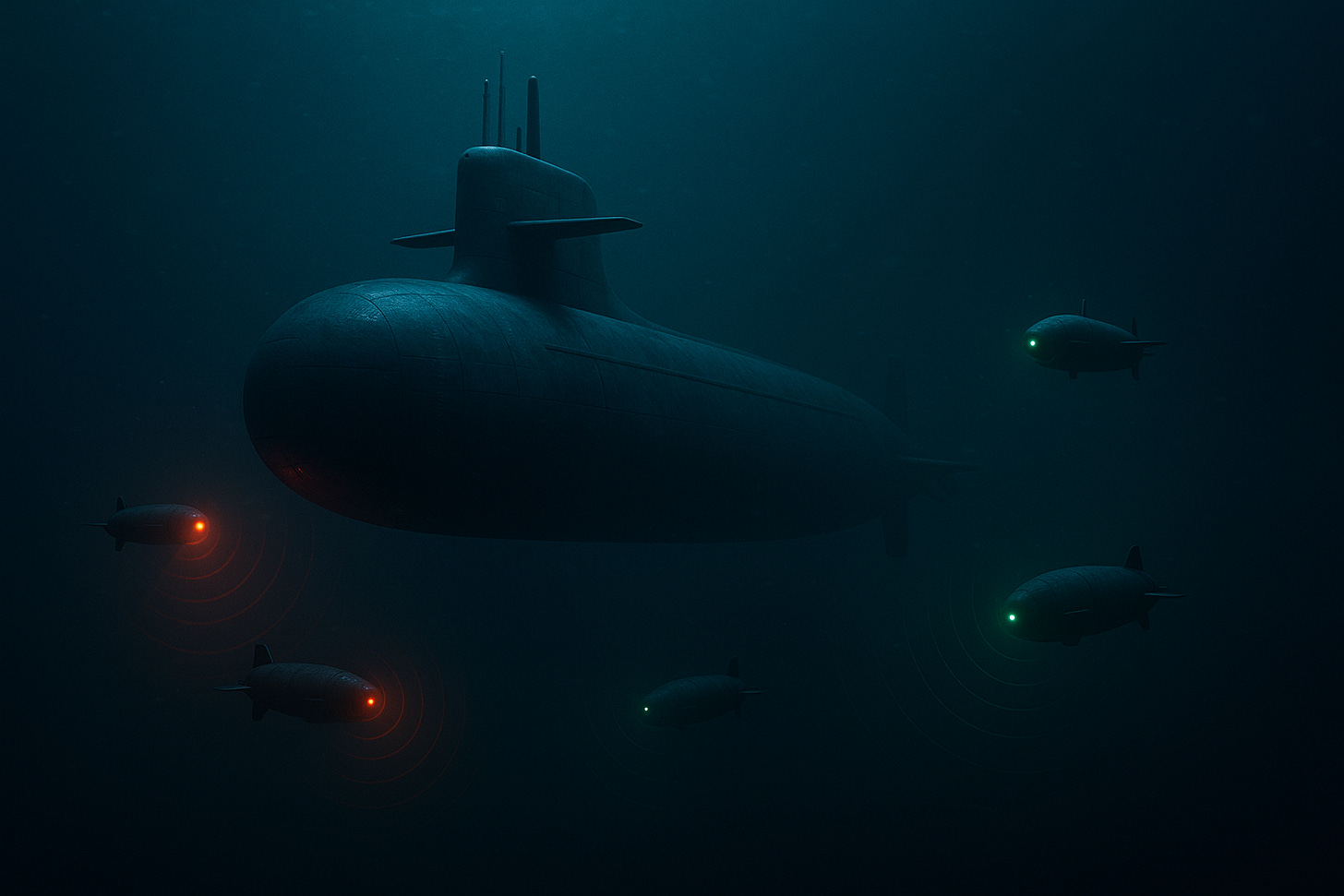Silent Hunters: Can Uncrewed Systems Threaten the Untouchables of Nuclear Deterrence?
Silent Hunters: Can Uncrewed Systems Threaten the Untouchables of Nuclear Deterrence?
Since the 1960s, ballistic missile submarines (SSBNs) have embodied the invisible cornerstone of nuclear deterrence. Their strength lies not only in their firepower but in their invisibility. Hidden in the vastness of the oceans, they guarantee a credible second strike: even after a devastating first blow, a nation retains the certainty of retaliation. This invisibility—more than the missiles themselves—has long been considered untouchable.
Yet recent advances in uncrewed systems challenge this assumption. The rise of maritime drones, both surface (USVs) and undersea (UUVs), is reshaping the balance of the silent war beneath the waves. Autonomous, relatively inexpensive, equipped with increasingly sophisticated sensors, and capable of operating in swarms, these systems contest a principle once taken for granted: that no technology could track an SSBN for long.
From bastions to contested oceans
During the Cold War, nuclear powers established “bastions”—sanctuarized oceanic zones where SSBNs could patrol in relative safety. The Barents Sea for the USSR, the Pacific for the United States, the North Atlantic for France and the United Kingdom became heavily protected areas, guarded by entire fleets dedicated to shielding their strategic submarines.
These bastions relied on two pillars: the natural cover of the deep ocean and the technological asymmetry between advanced submarines and limited detection methods. But that asymmetry is fading. The oceans are no longer inaccessible. Advances in robotics, artificial intelligence, and subsea energy now allow uncrewed platforms to patrol vast areas, capture faint signals, and, above all, share their data in real time. What was once a duel between a hunter and its prey becomes a distributed chase across an entire network.
The technological rupture of uncrewed systems
Surface drones equipped with radars, hydrophones, or deployable buoys can monitor strategic areas continuously, replacing costly and limited manned patrols. Undersea drones, thanks to long-endurance batteries and inertial navigation, can remain submerged for weeks, silently gathering acoustic anomalies.
Artificial intelligence transforms these fragments of data into decisive knowledge: recognizing attenuated reactor signatures, filtering ocean noise from mechanical anomalies, or fusing observations from multiple platforms into a coherent track of a submarine’s trajectory. The swarm thus becomes more than the sum of its parts—a collaborative system capable of mapping the unseen.
The United States is experimenting with large UUVs such as Boeing’s Orca XLUUV, capable of operating hundreds of miles from base with months of autonomy. China is investing massively in long-endurance undersea drones and permanent sensor networks in the South China Sea. Europe, through joint research programs, is also exploring the strategic implications of uncrewed maritime systems, from surveillance to counter-detection.
The risk of permanent traceability
The real threat is not a direct attack—which remains unlikely given the consequences—but the specter of permanent traceability.
An SSBN shadowed discreetly, even without open confrontation, loses its aura of invisibility. If an adversary can reliably track its location, the logic of deterrence is undermined: the promise of a second strike becomes conditional. A submarine that can be followed is no longer an unpredictable menace but a target on borrowed time. This alone is enough to weaken the entire edifice of nuclear deterrence, which rests less on use than on uncertainty.
The emerging threat of autonomous kamikaze drones
If uncrewed maritime systems already represent a challenge for detection and tracking, their evolution toward offensive autonomous weapons introduces a darker prospect.
Imagine a small undersea drone, built without the constraints of a crew, capable of diving far deeper than a nuclear submarine. With no need for oxygen or pressurized compartments, its architecture could be optimized for endurance and speed. In its final phase, it could employ jet-like underwater propulsion or even controlled supercavitation, accelerating to lethal velocity.
Such a system would not need advanced intelligence. A minimal AI—sufficient to recognize the acoustic fingerprint of a reactor, adjust course, and trigger an attack—would be enough. Conceived as an expendable hunter, it would not seek to survive but to strike. At terminal speed, even a relatively small impact could cripple or destroy an SSBN’s pressure hull, neutralizing its deterrent role.
This prospect turns the ocean into a battlefield of predators and prey where scale and cost are reversed. Billions invested in a single strategic submarine could be threatened by swarms of expendable drones, each costing a fraction of the target they hunt. Nuclear deterrence, long anchored in the “untouchable” invisibility of SSBNs, would find itself contested not by rival fleets, but by a multitude of silent, sacrificial machines.
Possible responses
How might navies adapt to this changing threat? Several responses are conceivable.
SSBNs could deploy their own escort swarms of defensive drones, creating a protective screen against hostile UUVs. New forms of undersea electronic warfare might emerge: acoustic jamming, intelligent decoys, or sonar spoofing to confuse autonomous trackers. Strategically, bastions may be redefined—not as static sanctuaries, but as dynamic, shifting zones defended by layers of collaborative systems.
This raises a deeper question: should SSBNs remain solitary guarantors of deterrence, or must their invisibility now be secured by an entire ecosystem of autonomous allies?
The future: a war of intelligences under the sea
The future of the oceans may be shaped by a confrontation of artificial intelligences, with swarms of drones hunting, deceiving, or neutralizing one another. Submarine warfare would no longer be defined solely by silence and patience, but by algorithms, networks, and attrition among autonomous systems.
The SSBN, long considered the ultimate guarantor of nuclear stability, may no longer be untouchable. While it still retains a technological and doctrinal edge, it now faces a new kind of adversary: autonomous hunters that threaten not its survival, but its invisibility. And in nuclear deterrence, the loss of invisibility is already the loss of credibility.


